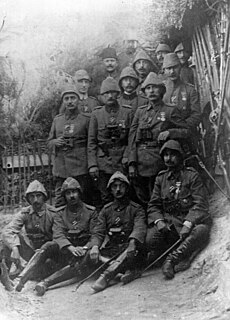This page is based on this
Wikipedia article Text is available under the
CC BY-SA 4.0 license; additional terms may apply.
Images, videos and audio are available under their respective licenses.

The Fifth Army of the Ottoman Empire or Turkish Fifth Army was formed on March 24, 1915 and dissolved on October 1918. It was assigned the responsibility of defending the Dardanelles straits in World War I. The original commander of the army was the German military advisor to the Ottoman Empire, General Otto Liman von Sanders. The command passed to Vehip Pasha who became responsible for the Helles front while von Sanders still wielded considerable influence.
The I Corps of the Ottoman Empire was one of the corps of the Ottoman Army. It was formed in the early 20th century during Ottoman military reforms.
The II Corps of the Ottoman Empire was one of the corps of the Ottoman Army. It was formed in the early 20th century during Ottoman military reforms.

The III Corps of the Ottoman Empire was one of the corps of the Ottoman Army. It was formed in the early 20th century during Ottoman military reforms.
The IV Corps of the Ottoman Empire was one of the corps of the Ottoman Army. It was formed in the early 20th century during Ottoman military reforms. It was disbanded at the end of World War I.
The V Corps of the Ottoman Empire was one of the corps of the Ottoman Army. It was formed in the early 20th century during Ottoman military reforms.
The VI Corps of the Ottoman Empire was one of the corps of the Ottoman Army. It was formed in the early 20th century during Ottoman military reforms. It is most notable for its participation in the offensive phase of the 1916 Romanian Campaign of World War I, where it was involved in heavy action all throughout the five months, inflicting heavy casualties on the Russo-Romanians and breaking through the Allied lines in several key areas. Additionally the VI Corps took 8,512 prisoners in Romania, including 6,512 Russians and 2,000 Romanians.
The VIII Corps of the Ottoman Empire was one of the corps of the Ottoman Army. It was formed in the early 20th century during Ottoman military reforms.
The XII Corps of the Ottoman Empire was one of the corps of the Ottoman Army. It was formed in the early 20th century during Ottoman military reforms.

The XIII Corps of the Ottoman Empire was one of the corps of the Ottoman Army. It was formed in the early 20th century during Ottoman military reforms.
The XIV Corps of the Ottoman Empire was one of the corps of the Ottoman Army. It was formed in the early 20th century during Ottoman military reforms.

The Sixth Army of the Ottoman Empire was one of the field armies of the Ottoman Army. It was formed in the middle 19th century during Ottoman military reforms.

The XV Corps of the Ottoman Empire was one of the corps of the Ottoman Army. It was formed during World War I.
The XVI Corps of the Ottoman Empire was one of the corps of the Ottoman Army. It was formed during World War I.
The XVII Corps of the Ottoman Empire was one of the corps of the Ottoman Army. It was formed during World War I.
The XVIII Corps of the Ottoman Empire was one of the corps of the Ottoman Army. It was formed during World War I.
The XX Corps of the Ottoman Empire was one of the corps of the Ottoman Army. It was formed during World War I.
The XXI Corps of the Ottoman Empire was one of the corps of the Ottoman Army. It was formed during World War I.
The XXII Corps of the Ottoman Empire was one of the corps of the Ottoman Army. It was formed during World War I.
The XXV Corps of the Ottoman Empire was one of the corps of the Ottoman Army. It was formed in Constantinople, Dersaâdet after the Armistice of Mudros.







